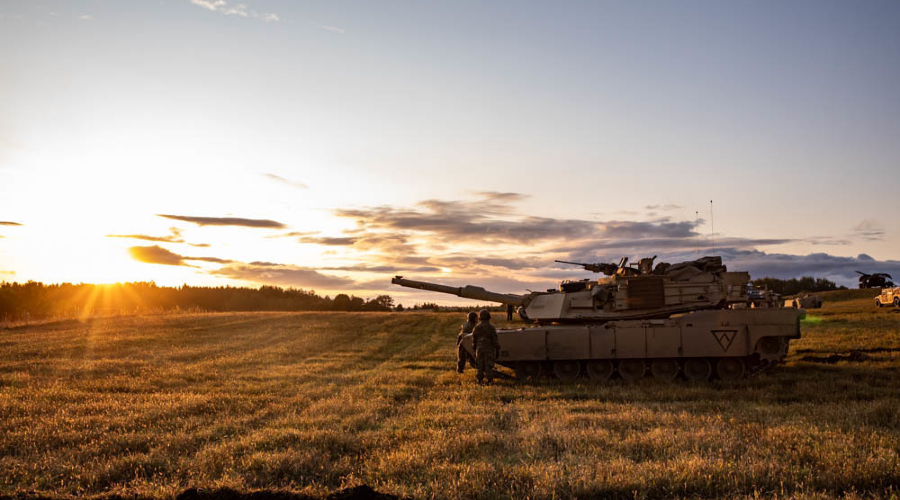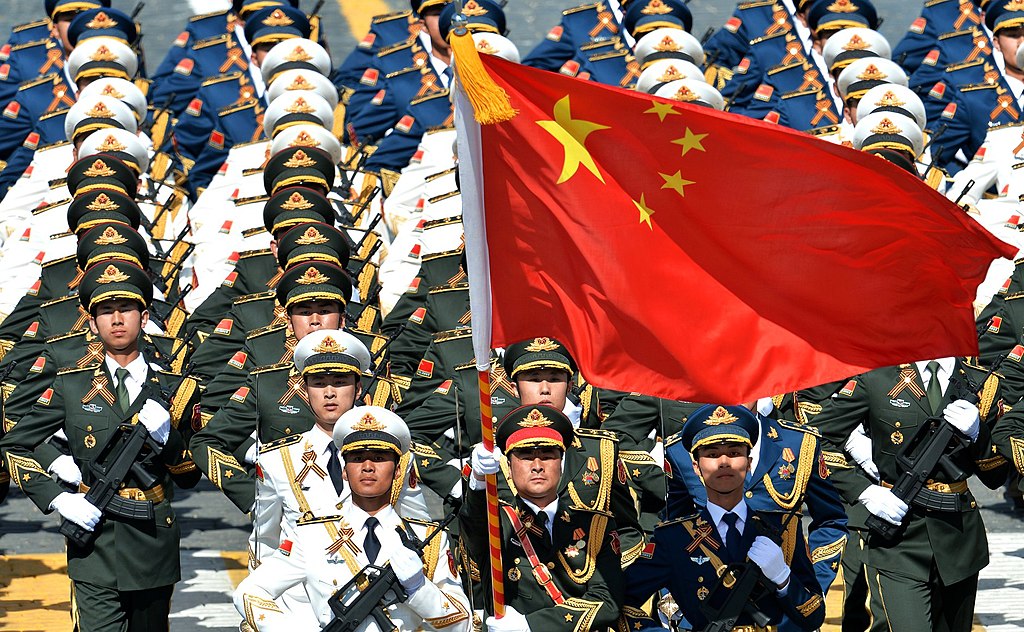Give NATO’s Eastern Flank Countries and Ukraine All the M1 Tanks

Published by The Lawfare Institute
in Cooperation With

Editor’s Note: As Ukraine’s offensive makes only limited progress, the United States and other allies of Ukraine are asking what can be done to make success more likely in the future. My Georgetown University colleague Ben Connable argues that the United States should transfer all of its Cold War equipment to allies, not only helping Ukraine today but also making Europe in general far stronger in the future.
Daniel Byman
***
As long as it is official U.S. policy to support Ukraine against the Russian invasion, the United States and its allies should do their utmost to help the country win. Western leaders have proved willing to stick their necks out, sending the Ukrainians billions of dollars in aid, advanced missiles, armored vehicles, and other equipment while reducing their own ammunition reserves. High-performance F-16 Falcon fighter-bombers are in the pipeline. Given the stakes, these are all commendable steps.
But these steps have proved inadequate to achieve battlefield success. Both grand scale and enduring commitment are needed to achieve the ostensible core Western strategic objective in this war: a stable and lasting peace obtained under conditions favorable to Ukraine and the NATO alliance.
Ukraine certainly would not be on the offensive today without Western, and particularly U.S., support. Despite this essential support, Russia maintains an approximately 10-to-1 numerical advantage in artillery, has probably twice as much infantry as Ukraine, and fields more overall armor. Attackers generally need an advantage in ground combat mass to win. Drones are useful, but they do not provide concentrated mass. Inadequate mass arguably has precluded the kind of breakthrough the Ukrainians were able to achieve in the northeast in late 2022. Western nations cannot provide infantry, but they can provide more artillery, armor, and combat aircraft to help the Ukrainians achieve the local fire superiority and mass they need to take ground and defend against another prospective Russian offensive.
While Western aid has been generous and in many cases timely, hand wringing over some incremental military disbursements may have prolonged the conflict. A good example of this nervous incrementalism is the long-running debate in the United States over whether to send even just a handful of M1 Abrams tanks to Ukraine. For months after the invasion, the idea of sending any tank was viewed as unreasonably escalatory. When U.S. leaders eventually warmed to the idea of sending tanks, the defense bureaucracy balked.
Defense officials threw out many red flags to argue against the move: The Ukrainians could never successfully operate the complex M1 in combat, they argued. Logistics requirements were too steep. Training would take too long. In January 2023, nearly a year after the invasion, an agreement was finally reached to send just 31 M1A2 Abrams tanks—a relatively small number, but of a more recent model of the tank. Accounting for routine maintenance and breakdowns, that would be enough to outfit about a company of vehicles in direct combat. But shortly after the initial approval, these updated models were (perhaps reasonably) deemed too advanced for export into a combat zone where they might be captured by the Russians. This plan was revised as the summer counteroffensive dragged on. A first, small tranche of Abrams tanks arrived in late September, just on the cusp of winter and an inevitable, weather-driven operational slowdown.
Delivery of essential war materiel at this small scale and sluggish pace will not allow the Ukrainians to achieve strategic success on the ground. It may put at risk their ability to hold the front line, which is more than 1,000 kilometers long, as Russia works to reset its defense industry and obtains fresh support from North Korea and, probably, China. A grander vision is needed for what will almost assuredly be a longer war. Given the divided political climate in the United States and wavering public support for the war, any such vision must deliver clear, mutual benefit to both Ukraine and the United States. This can be accomplished by drawing on the U.S. reserve of equipment from the Cold War.
Proposal: Transfer the Cold War-Era Arsenal of Democracy to Eastern Europe
The United States should begin working with its allies and partners to establish infrastructure across Eastern and Northern Europe to receive the entire inventory of core, Cold War-era U.S. ground combat and close-air-support systems. This equipment can be delivered under any suitable legal framework, including the new Lend-Lease Act. As the logistics and maintenance backbone to support these systems is built along NATO’s eastern flank, ready assets can be pushed steadily into Ukraine. Drawing on the arsenals of the United States and its partners, this eventually would include at least thousands of 1980s-era M1 Abrams tanks and M2 Bradley infantry fighting vehicles, hundreds of M109 Paladin mobile howitzers and M270 multiple-launch rocket systems, as well as hundreds of AH-64 attack helicopters and A-10 Thunderbolt II (Warthog) and F-16 Falcon ground-attack aircraft, all designed from the ground up to defeat the Russian military currently fielded in Ukraine.
This large-scale commitment would guarantee the Ukrainians a steady supply of the integrated combined-arms assets necessary to sustain battlefield momentum, prevent a renewed Russian offensive toward Kyiv, and help deter future Russian aggression for decades to follow. This grand-vision approach would also simultaneously deliver three direct benefits to the United States. It would transfer the physical capability to defend Europe to the Europeans; resolve decades of acquisitions missteps and inertia, allowing the United States to invest in a new generation of combined-arms equipment; and provide an enduring market for the existing U.S. industrial base tailored to produce Cold War-era equipment.
All of this can be done without draining U.S. military power. Combat-ready tanks, artillery systems, and jets would be kept in the U.S. military’s front-line units until replaced by new equipment. Even after transferring all of this Cold War gear, the U.S. military would still be armed with the most modern and advanced jet aircraft, including the F-35 Lightning II and B-2 stealth bombers. It would continue to field the world’s best mechanized and amphibious infantry, armed to the teeth with missiles capable of killing any armored vehicle currently manufactured. Army units would field the new (and brilliantly simple) M-10 Booker light tank, as well as a modern replacement for the Bradley. Neither of these new armored vehicles will be tailor-made to fight the current Russian ground forces in Europe. But this gap would be significantly mitigated if Europeans field refurbished—and lethally upgraded—U.S. gear designed specifically for that purpose.
Transfer the Capability to Defend Europe to Europeans
U.S. national and defense strategies are predicated on coalition warfare and a “by, with, and through” approach to international security. Since the end of the Cold War, U.S. leaders from both political parties have been working to reduce the need for a costly military presence on the European continent and to shift the burden of defending Europe to Europeans.
In parallel, however, broader enthusiasm for the NATO mission waned and key alliance members like Germany and the United Kingdom reduced their military forces almost to the point of operational irrelevance. France and Turkey maintained robust ground combat forces, but most of the other alliance members barely sustained sufficient capacity to participate in combined ground combat exercises. Even if Olaf Scholz’s Zeitenwende bears fruit, it may take a decade or more before Germany is able to retool and grow its defense industry so that it can defend even its own soil from a prospective Russian invasion. Meanwhile, U.K. leaders are moving in the opposite direction, further gutting the already anemic British ground forces.
Many Eastern European and Scandinavian militaries—in Poland, Estonia, Romania, Finland, and Ukraine, among other countries—are ready to pick up the torch that their Western partners have dropped. The Poles and Ukrainians probably are the most universally enthusiastic. Since the invasion in February 2022, Poland has fully and collectively invested in the belief that Russia represents a pressing existential threat. Poland is ready, willing, and—with some necessary help—able to defend itself and to support the defense of Ukraine. It also has the basic industrial infrastructure, human capital, and ideal geographic position to become NATO’s new forward “arsenal of democracy.”
Poland is presently slated to receive more than 360 M1 Abrams tanks. This delivery will put it on track to build the kind of infrastructure necessary to support these vehicles, repair them, train crews, and stock war reserves. Polish forces already fly and maintain F-16 Falcons and other U.S. equipment. Latvia, Lithuania, Estonia, and other Eastern European NATO members are also well attuned to the Russian threat and can be linked in to an Eastern-flank infrastructure, albeit at smaller scale. Finland has its own defense capabilities and operates a mix of German, Russian, U.S., Swedish, and domestically manufactured equipment. But as one of the newest NATO members, Finland will want to take some steps to further standardize its equipment and weapons with alliance partners.
Delivery of the entire Cold War inventory would necessarily take considerable time, probably 20 years or more. First, older and even mothballed boneyard equipment would be transferred forward as repair and refurbishment centers are built. Export-model tanks in allied and partner inventories could be quickly pushed out and then backfilled from U.S. stocks. Gradually, a forward-positioned stock of tanks, fighting vehicles, mobile artillery, supporting equipment, attack helicopters, and jets—all compatible with U.S. training and logistics—would be set north to south along NATO’s eastern defensive boundary, effectively replicating the Cold War-era network of resilient and redundant storage points.
The costs of maintaining this defensive belt would be transferred to Europe. Eastern European and Scandinavian soldiers would manage and train on the equipment, but the stocks could also be used as forward-positioned war reserves for U.S. forces. With support from the U.S. defense industry, Ukrainians could provide the skilled and unskilled labor needed to improve the older tanks, trucks, fighting vehicles, cannons, and, eventually, aircraft to ready combat standards.
This would provide Ukraine the ongoing support it needs to win its war with Russia, while also arming the country to NATO standards and building up the industrial talent necessary to sustain its force. Meanwhile, to mitigate near-term risk and allow for transition to this new equipment, U.S. and partner forces would keep all the newest and most effective versions of these vehicles and aircraft until they were adequately and safely replaced by a new generation of ground combat systems. This shift to new systems has been too long in the works.
Force the Modernization of U.S. Military Equipment
For at least the past two decades, U.S. Army, Air Force, and Marine Corps leaders have been working to trade in their Cold War-era equipment tailored for land war in Europe. For a variety of reasons, most of these efforts have failed. By late 2023, the Marine Corps had dropped most of its Cold War kit because it was deemed unsuitable for island campaigning in potential conflicts with China in the Asia-Pacific region. Army leaders also recognize the unsuitability of Cold War ground combat gear for its Pacific theater missions, but they still primarily field these legacy armor and helicopter systems, and the Air Force still flies the A-10 Warthog and half-century-old F-16 Falcons.
All of these systems were built for one collective Cold War purpose: to defend Western Europe against a Soviet invasion from its eastern flank. Each system was tailor-made to fight against and defeat the exact same (or somewhat modified) equipment currently fielded by Russian forces in Ukraine. The M1 Abrams gun, thermal sights, speed, and armor are specifically designed to overmatch Russia’s T-72 and more advanced T-90M tanks.
Collectively, these systems formed a larger, integrated ground combat team. They all worked well together to crush the Iraqi Army in 1991 and in 2003. They also functioned fairly well in some counterinsurgency roles in Iraq and Afghanistan, providing U.S. troops with the mobile firepower needed to overmatch ground adversaries. But they were also cumbersome, costly, and sometimes ill suited for the wide array of terrain encountered outside of Europe.
Though many of the previously envisioned replacement designs for these Cold War systems have been bloated, fantastical, and based on inadequate objective analysis, U.S. defense leaders have clearly articulated the need for new and more globally flexible systems. Pushing existing stocks out of the U.S. inventory would stimulate the transition to new systems while sustaining the existing U.S. defense industrial base.
Sustain the U.S Defense Industrial Base
It is possible to simultaneously help Ukraine to repel the Russian invasion, transfer defense capabilities to Europe, divest aging equipment from the U.S. military, and invest in a new generation of combat kit. A wholesale transfer of Cold War equipment would also directly benefit the U.S. industrial base and sustain defense industry employment over time.
When any of the four military services buys a major new system like a tank or fighter-bomber, U.S. defense corporations make major bets on decades-long contracts: They build large factories; create unique and costly machinery; buy specially tooled robots; and train American workers to manufacture these systems, sustain them, and provide service-life upgrades as they age. Despite the emergence of additive manufacturing and other advanced industrial technologies, this U.S. defense industrial approach still remains generally in place.
Take, for example, the World War II-era tank manufacturing plant in Lima, Ohio. The Lima plant is the only remaining major tank producing facility in the United States. It is owned by the Army and run by General Dynamics, a key defense contractor. While workers at the Lima plant no longer build brand new M1 tanks, they do continuously refurbish old Abrams for the U.S. military and partner nations. (They also will play a central role in building the new M10 Booker.) Abrams tank component manufacturers employ many hundreds, and perhaps thousands, of other workers in Florida, Arizona, Indiana, and Alabama. With a new, widespread, and enduring market in Eastern Europe, these American workers could continue to help upgrade the Abrams fleet for Poland, Ukraine, and other new users, while also gradually shifting to the production of new vehicles.
Work on existing M1 frames at the Lima plant almost certainly could be sustained for several decades as the European industrial base comes online. The same could be true at the Bradley and M109 refurbishment facilities in Pennsylvania and Alabama, the M270 plants in Arkansas and Texas, the AH-64 Apache plant in Arizona, the A-10 Warthog plant in Georgia, the F-16 plant in South Carolina, and all of their subsidiary component manufacturers in California, New Jersey, Utah, Virginia, and other states. Partner users of U.S. arms routinely pay U.S. defense companies for refurbishment, munitions, and training. The partners get effectively brand-new U.S. gear, and U.S. companies make profits, keep factories open, and sustain baseline industrial capacity. For example, in 2020 Egypt signed a $2.3 billion contract for the refurbishment of 43 Apache helicopters at plants in Arizona and Florida. This kind of sustained, large-scale business with European partners also would be mutually beneficial.
Objections and Objectives
There will, of course, be both reasonable and knee-jerk objections to this plan. Complex foreign military sales and financing regulations would make a grand-scale arms transfer difficult. New backfill systems might underperform in some future war, requiring at least partial recoupment from European stocks. Even though Russia suspended participation in the Treaty on Conventional Forces in Europe (CFE) in 2007, and even though a full transfer of systems almost certainly would fit well within the original CFE force limits, Russia can be expected to describe even the consideration of such a plan as escalatory. And in the politically charged and risk-averse climate in Washington today, grand plans generally are dead on arrival.
Still, if objections and obstacles can be overcome, this grand vision can deliver what current half-measures cannot. Ukraine would get the tailor-made materiel it needs to help expel Russia from its territory. The United States would transfer most of the burden of defending Europe to Europeans. U.S. military services would get the new equipment they need, as well as forward-positioned war reserves they would not be required to maintain. And the American people would get a more sustained, robust defense industrial base, paid for in part by European allies and partners.
Those European allies and partners would get the equipment they need to defend themselves without having to retool their economies or exsanguinate their national budgets to build all new kit. They certainly will continue to build their domestic industries and turn out new equipment in parallel; U.S. combined-arms capabilities would complement, not fully replace all European arsenals.
An additional and important benefit would accrue for the United States: U.S. ground and air forces freed up from heavy commitments in Europe could be recommitted to counter Chinese influence, deter Chinese aggression, and pad out global crisis response forces stretched thin by current commitments.
Only the Russians and the Chinese are guaranteed to be unhappy with this plan. That is, arguably, one more good measure of success.


.jpg?sfvrsn=cbb26fe8_9)


